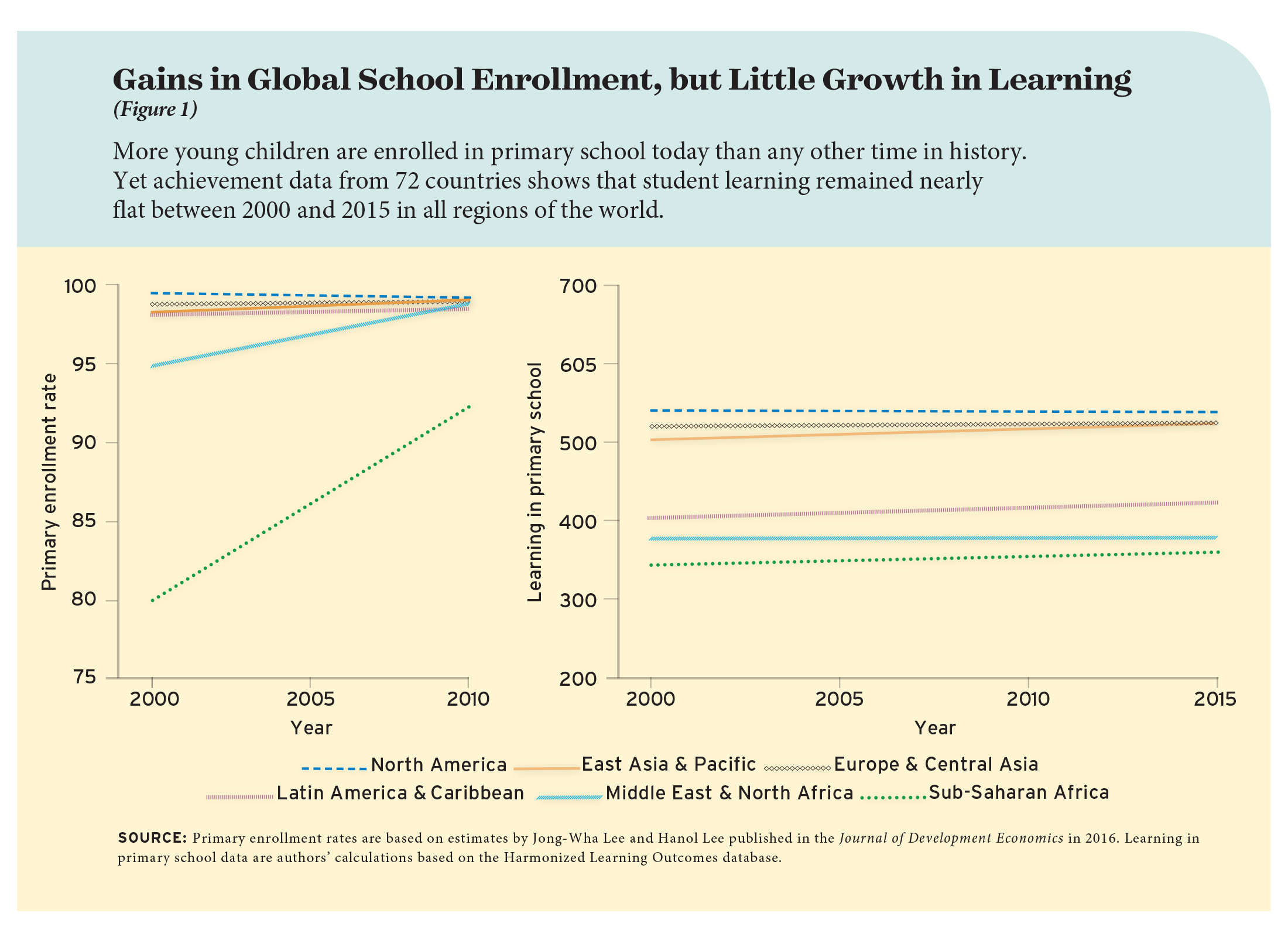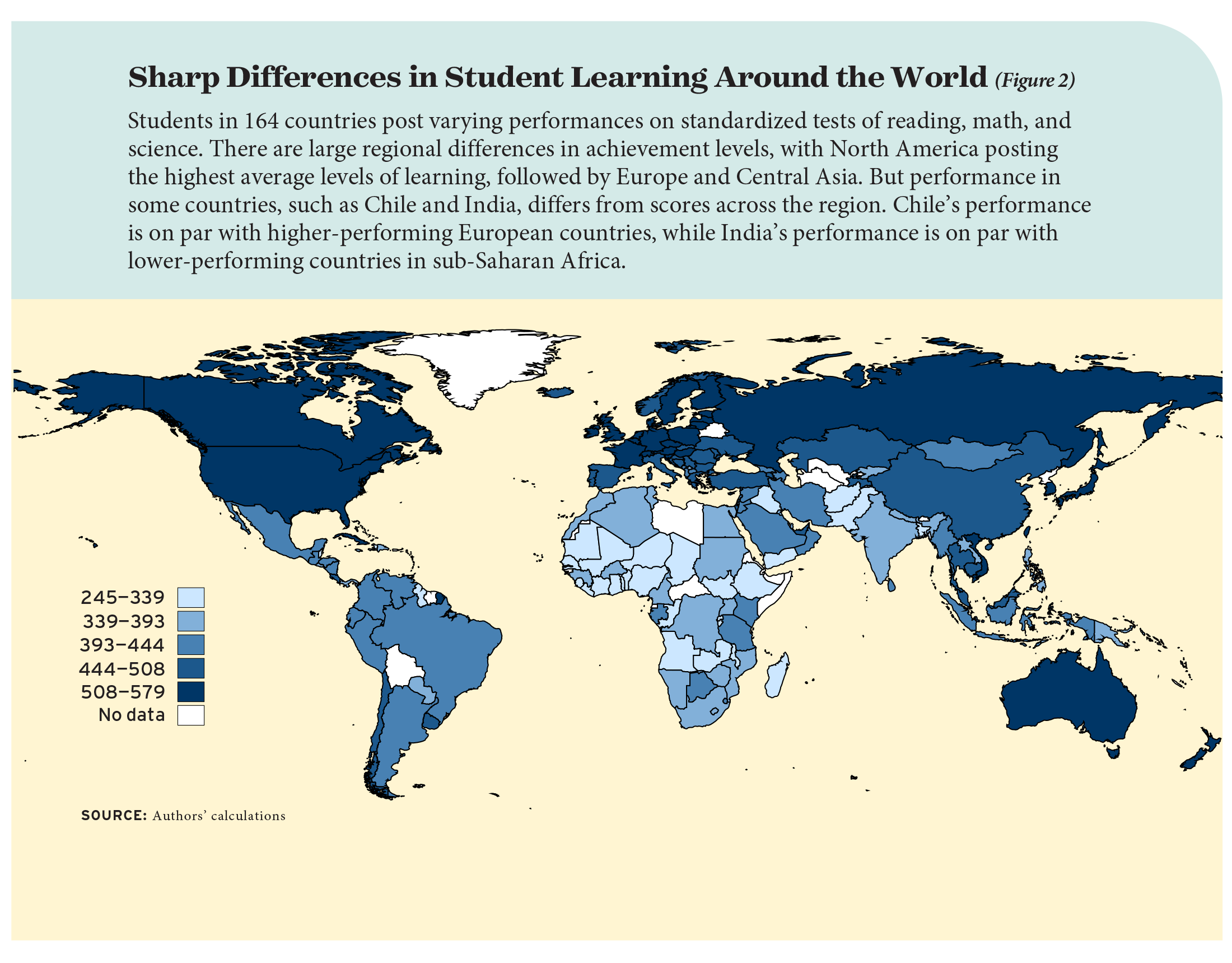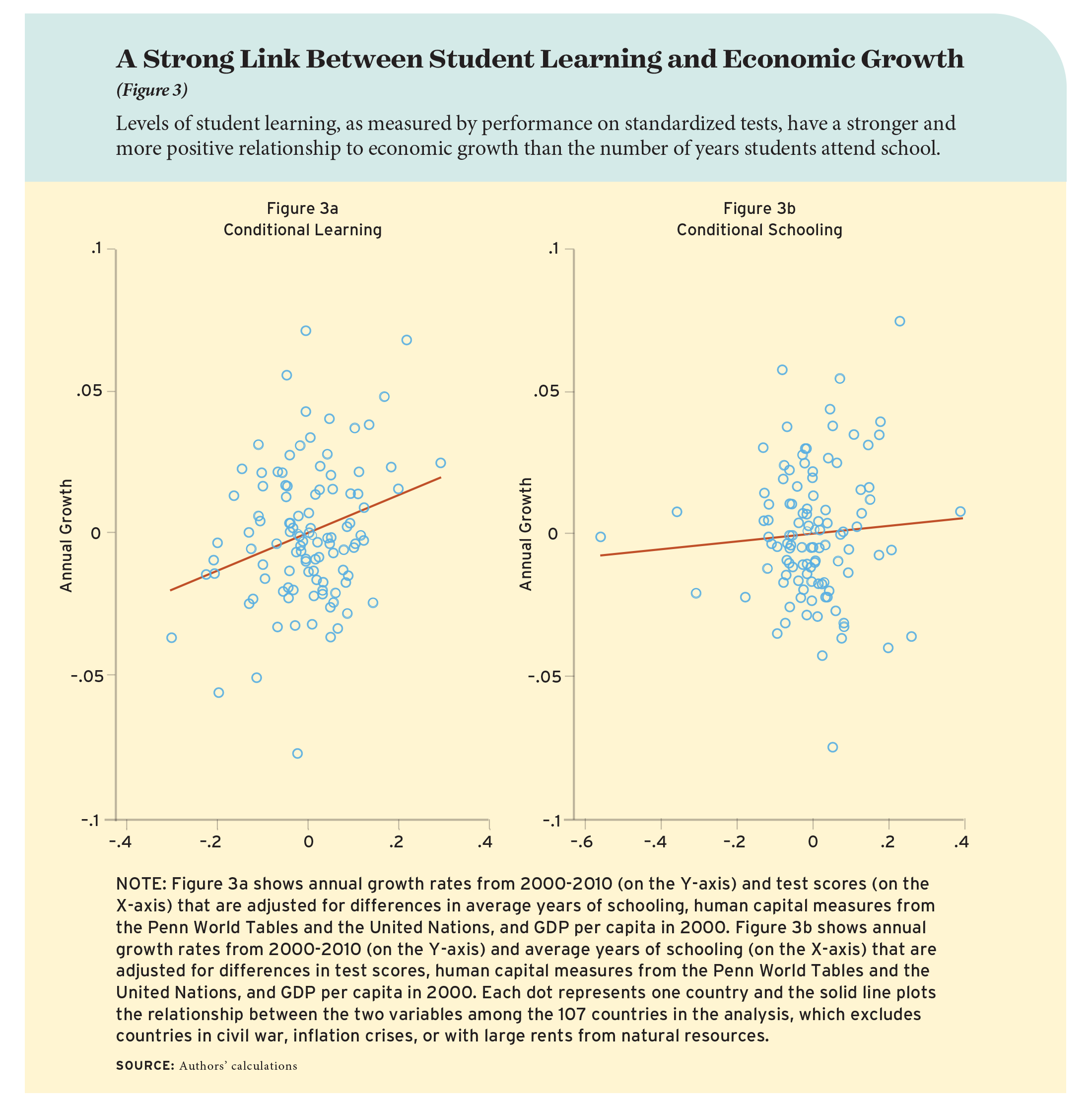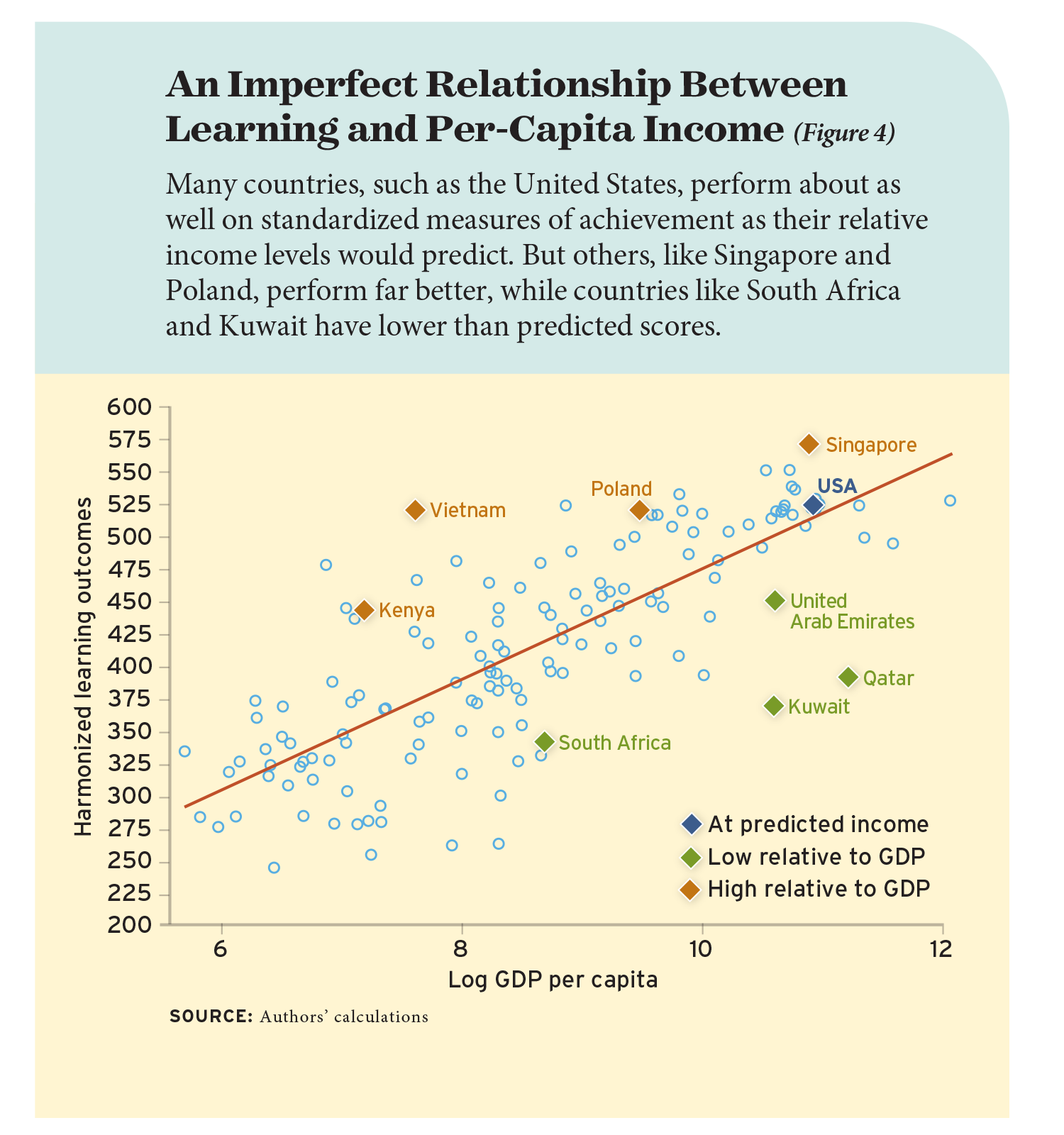There are more children in school worldwide today than at any other time in history, pandemic-related disruptions notwithstanding. In 2010, the average adult had completed 7.6 years of school, more than double the 3.2 years completed by the average adult in 1950. These estimates, based on our review of data from 164 countries around the world, appear to represent a substantial achievement toward human progress. In particular, they would seem to indicate the potential for dramatic economic growth in the developing world, which accounts for much of the enrollment difference.
But does more schooling necessarily lead to economic progress? Development experts have long argued that an expansion in school enrollments would equip the next generation with knowledge and skills to enhance their economies and promote a better quality of life. But a new database of detailed student-achievement data suggests that greater school enrollments have been followed by little to no growth in learning in most parts of the world.
We constructed the Harmonized Learning Outcomes database by linking regional assessments of core academic subjects in less-developed countries to international achievement tests commonly administered in the wealthier parts of the world. This database of 164 countries allows us to compare student performance in regions that are typically excluded from international comparisons, such as sub-Saharan Africa and Latin America, to that of more affluent students in Europe and North America. Our data cover 98 percent of the global population and track student-learning outcomes from 2000 to 2017.
We find that while rates of school enrollment topped 90 percent in every region by 2010, learning outcomes are low and have barely budged over the past couple decades. Students are in school, but they learn very little.
Wealthy countries like the United States are not immune to what international aid organizations have termed the global “learning crisis.” In North America, where school enrollment rates have been high for decades, our database shows that student performance on standardized tests in reading, math, and science barely budged between 2000 and 2015. Meanwhile, countries that have made dramatic progress in achieving high rates of schooling, such as Brazil and Ghana, still have very low rates of student learning.
Expansion in access to school may provide more opportunities to learn and may have other benefits as well, but schooling does not guarantee learning, and the relationship is not one to one. To understand the potential benefits of the global growth of education to economies around the world, we cannot assume that schooling leads to learning. Measuring learning directly is essential.
An Expanded Inventory of Student Learning
In recent decades, international assessments such as the Programme for International Student Assessment and Trends in International Mathematics and Science Study have measured student learning in a steadily growing number of countries. In 2015, students in 71 countries took the PISA, and students in 65 countries took the TIMSS.
These psychometrically designed, standardized assessments of cognitive skills enable global comparisons of learning across countries and over time. However, these tests exclude many low- and middle-income countries, which makes it difficult to analyze learning patterns in the developing countries that may have the most to gain from improving education quality.
To bridge this gap in learning outcomes data, we built the new Harmonized Learning Outcomes database, which includes measures of student learning that cover 98 percent of the global population. The database expands the number of countries surveyed to 164, two-thirds of which are developing countries, by linking international assessments to their regional counterparts. For example, rather than the PISA or TIMSS, most students in sub-Saharan Africa take exams administered by the Southern African Consortium for Monitoring Education Quality, and most students in Latin America take tests from the Laboratorio Latinoamericano de Evaluación de la Calidad de la Educación. Altogether, our database includes seven assessment regimes: three international tests that are global in scope, three regional tests, and the Early Grade Reading Assessment. The latter provides at least one data point in the past 10 years for an additional 48 countries, including large developing economies such as Bangladesh, Nigeria, and Pakistan. Each test covers between 10 and 72 countries.
To create comparable measures, we convert regional test scores to an international scale within subjects, which include mathematics, reading, and science, and within levels of schooling, such as primary or secondary. This is possible when one or more countries participated in both a regional and an international test in adjacent years during our target period of 2000 to 2017. We then apply this conversion to countries that participate in a regional test but not an international test to produce comparable scores, which we call Harmonized Learning Outcomes. On this scale, a score of 625 is considered high performance. The scores of individual countries vary; for example, in the latest available year, the United States has a score of 545, Mexico has a score of 453, and Uganda has a score of 391.

Schooling Isn’t Learning
The scores show that progress in learning has been limited over the past two decades, even where schooling opportunities have expanded. Looking across regions, we find 72 countries with data for primary school that include at least two data points for both enrollment and learning. First, we consider enrollment rates based on estimates from Jong-Wah Lee and Hanol Lee, which show a clear pattern of high and increasing school enrollment through 2010. Then we compare that to trends in student learning based on estimates from our database, which show little to no progress in every region of the world (see Figure 1).
For example, in the Middle East and North Africa region, enrollment rates for primary education increase to 99 percent by 2010. However, from 2000 to 2015, learning levels remain at around 380—not far above the low-performance benchmark of 300. In looking at individual countries, we find that many developing countries have achieved substantial levels of schooling but have not yet realized high rates of learning. Ghana has 11.6 years of expected schooling, yet its learning score of only 229 does not meet the low-performance benchmark. Brazil has reached 11.7 years of expected schooling, yet achieves a learning score of just 426—far below the high-performance benchmark of 625.
These findings reinforce messages in a 2018 report by the World Bank, which similarly highlighted the acute gap between schooling and learning in developing countries. For example, in Kenya, Tanzania, and Uganda, three-quarters of the students in grade 3, who are typically eight or nine years old, cannot read a basic sentence such as “the name of the dog is Puppy.” And in rural India and Uganda, more than 80 percent of grade 2 students cannot solve a subtraction problem with numbers greater than 10, such as 46-17.
It is possible that in regions such as sub-Saharan Africa, as enrollment grows substantially higher, and new, lower-performing students participate in learning assessments, average scores decrease owing to a selection effect. In particular, strong enrollment growth since 2000 points to this possibility. These enrollment increases followed prominent declarations, such as “Education For All,” as well as the introduction of compulsory schooling laws and the elimination of school fees in many developing countries. However, we observe slow learning progress even in regions where enrollment levels are relatively constant and high, such as North America and the Caribbean. This suggests that there is more to these trends than selection.
We also calculate average learning levels in reading, math, and science in primary school in all 164 countries represented in our database. Average learning levels in high-income countries far outpace those in developing economies (see Figure 2). In looking across regions, we find that North America has the highest average learning levels, followed by Europe and Central Asia. Meanwhile, sub-Saharan Africa and South Asia have the lowest average learning levels.
However, the performances of individual countries in these regions varies, and some countries buck regional trends. For example, in sub-Saharan Africa, countries such as Kenya and Tanzania have higher average levels of learning, on par with many countries in Latin America. Within Latin America, a few higher-performing countries such as Chile are on par with learning levels in Europe. Most countries in the Middle East perform similarly or worse than those in Latin America, while some Asian countries, such as Singapore, outperform North America and Europe.

Learning, More Than Schooling, Is Linked with Economic Growth
These differences have broad implications for countries’ economies that are not yet fully captured in leading measures of global development. For example, the Human Development Index published by the United Nations, which creates a single country-level measure of well-being based on average life expectancy, education, and standard of living, uses numbers of years of schooling as its proxy for human capital. While access to school correlates with multiple measures of national well-being, prior research has shown that the relationship between years of schooling and economic growth is weak. By contrast, measures that use learning to define human capital are more strongly associated with economic growth (see “Education and Economic Growth,” research, spring 2008).
The Harmonized Learning Outcome data allow us to document these patterns on a global scale (see Figure 3). When we use students’ test scores to define a country’s human capital, the scores account for between one-fifth to around half of differences in income levels among countries. That is nearly twice as much as when those estimates are based on the amount of schooling the average student in a country receives. Learning has a stronger and more positive relationship with economic growth than schooling.

However, greater incomes do not inevitably produce a more educated and skilled society. We looked at per-capita income and average levels of learning for all of the countries in our database and found broad variation in countries’ performance relative to what their incomes would predict (see Figure 4). For example, the United States, when compared to all other countries, does as well as its per-capita income level predicts. However, it underperforms some countries with similar income levels, like Singapore. We also find countries that are much less developed but do just as well, such as Poland and Vietnam, along with other rich countries, such as several in the Middle East, that drastically underperform the achievement level expected given the per-capita income. This may be because their economies rely heavily on natural resources, which requires a lesser investment in education, rather than on highly skilled labor, which requires high levels of human capital. South Africa and Kenya provide another notable contrast, with Kenya outperforming its much richer regional neighbor.

Focus on Student Learning
This analysis gives us both good and bad news to share. The good news: the world is on track to achieve universal primary-school enrollment by 2030. The bad news: there is little progress in learning outcomes in most countries. Our results show the learning crisis is worldwide.
Now is the time to take action. Data from high-income countries, where standardized tests that measure student learning are regularly administered, show that estimates of economic growth based on learning outcomes are far more predictive than those based on enrollment. Those estimates have often not been available on a globally comparable scale for middle- and low-income countries.
We must shift our focus to measuring and advancing learning as a priority goal around the world, just as we have measured and improved access to schooling for the past 50 years. The world largely succeeded in greatly expanding schooling, in part because it was measured carefully and consistently. Learning must receive the same attention and care.
Our global database and analysis can point the way. With the expansion of standardized testing and new tools to make clear comparisons across assessments administered around the world, we can measure learning more accurately and more completely than in the past. Countries need to provide students with more than just access to school. Around the world, citizens need the educational experiences that promote higher levels of learning to ensure global prosperity in the twenty-first century.
Noam Angrist is a fellow at the University of Oxford, cofounder of Young 1ove, and a consultant with the World Bank, where Harry Patrinos is practice manager. Simeon Djankov and Pinelopi Goldberg, both formerly of the World Bank, are senior fellows at the Peterson Institute for International Economics. Goldberg is also the Elihu Professor of Economics at Yale University. This article is adapted from a paper originally published in Nature in March 2021, Measuring human capital using global learning data.
This article appeared in the Spring 2022 issue of Education Next. Suggested citation format:
Angrist, N., Djankov, S., Goldberg, P., and Patrinos, H. (2022). Mapping the Global Learning Crisis: Despite record enrollments in school worldwide, learning is limited. Education Next, 22(2), 50-56.


